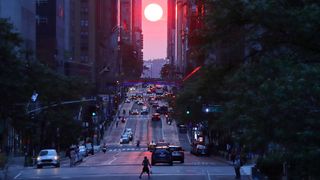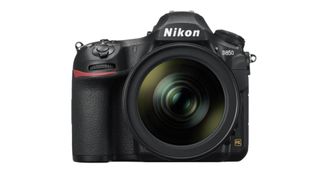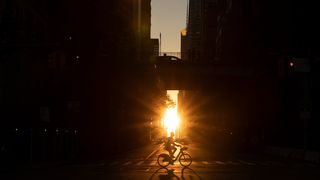First 'Manhattanhenge' of 2022 will beam sunset between NYC buildings on Memorial Day weekend
Catch the show on May 29 and 30, weather permitting.
New York City's special solstice is just around the corner.
Big Apple residents and visitors can catch the gorgeous "Manhattanhenge" this Memorial Day weekend as the sun sets between buildings on Sunday (May 29) and Monday (May 30), particularly if you're around 14th, 23rd, 34th, 42nd and 57th Streets.
The phenomenon occurs twice a year when the setting sun aligns with east-west oriented streets in New York City, weather permitting. If you can't catch it, the next opportunity will be July 12 and 13, according to EarthSky.
Related: Stonehenge may have been used as a solar calendar


If you're looking for a good camera for astrophotography, our top pick is the Nikon D850. Check out our best cameras for astrophotography for more and prepare for the tau Herculids with our guide on how to photograph a meteor shower.
"Viewers can also witness the phenomenon from the Tudor City Overpass in Manhattan, or Hunter's Point South Park in Long Island City, Queens," EarthSky stated.
"Regardless of where you watch the sunset," EarthSky added, "make sure you're as far east as possible, while keeping New Jersey in the background across the Hudson River, to accentuate the effect."
The name "Manhattanhenge" borrows from Stonehenge, the famous English Neolithic monument whose sarsen stones and orientation with landmarks in the surrounding area are meant to reflect the movements of the sun, according to monument caretaker English Heritage.
Get the Space.com Newsletter
Breaking space news, the latest updates on rocket launches, skywatching events and more!
"If you were to stand in the middle of the stone circle on midsummer's day, the sun rises just to the left of the 'Heel Stone', an outlying stone to the north-east of the monument," English Heritage stated.
The winter solstice also has an alignment, English Heritage added. "On midwinter's day, turning 180 degrees to face towards the south-west, the sun would originally have set between the two uprights of the tallest [stone monument], at the head of the sarsen horseshoe."
While the summer solstice tends to attract celebrants, COVID conditions permitting, archaeology suggests the winter solstice might have been more important in the Neolithic, English Heritage said on another page. That's because Durrington Walls, a settlement just 2 miles (3 km) from Stonehenge thought to host the monument's builders, has extensive evidence of feasting during the colder months.

Many urban environments receive the same effect as Manhattan experiences at some point in the year, due to the sun's orientation relative to the buildings, EarthSky explained.
That's because the sunset's position on the horizon is always shifting because of the inclination of the Earth's axis to our orbit. Manhattan's city grid tends to be at 29 degrees east of true north to reflect the orientation of the island.
"At this time of year — between the March equinox and June solstice — the sunset point is shifting northward each day on the horizon as seen from around the globe," EarthSky stated.
"It's the northward-shifting path of the sun that gives us summer in the northern hemisphere and winter in the Southern Hemisphere ... it's the shifting path of the sun that gives people various alignments of the sunset with familiar landmarks."
Follow Elizabeth Howell on Twitter @howellspace. Follow us on Twitter @Spacedotcom and on Facebook.
Join our Space Forums to keep talking space on the latest missions, night sky and more! And if you have a news tip, correction or comment, let us know at: community@space.com.

Elizabeth Howell (she/her), Ph.D., is a staff writer in the spaceflight channel since 2022 covering diversity, education and gaming as well. She was contributing writer for Space.com for 10 years before joining full-time. Elizabeth's reporting includes multiple exclusives with the White House and Office of the Vice-President of the United States, an exclusive conversation with aspiring space tourist (and NSYNC bassist) Lance Bass, speaking several times with the International Space Station, witnessing five human spaceflight launches on two continents, flying parabolic, working inside a spacesuit, and participating in a simulated Mars mission. Her latest book, "Why Am I Taller?", is co-written with astronaut Dave Williams. Elizabeth holds a Ph.D. and M.Sc. in Space Studies from the University of North Dakota, a Bachelor of Journalism from Canada's Carleton University and a Bachelor of History from Canada's Athabasca University. Elizabeth is also a post-secondary instructor in communications and science at several institutions since 2015; her experience includes developing and teaching an astronomy course at Canada's Algonquin College (with Indigenous content as well) to more than 1,000 students since 2020. Elizabeth first got interested in space after watching the movie Apollo 13 in 1996, and still wants to be an astronaut someday. Mastodon: https://qoto.org/@howellspace
